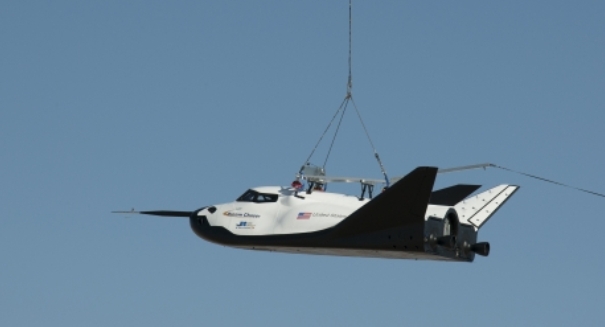
All tested Dream Chaser capabilities were fully functional during the flight.
The Sierra Nevada Corporation, a NASA partner firm based in Louisville, Colorado, completed the second captive-carry test of its new Dream Chaser spacecraft last Thursday. According to a press release from NASA, the test took place at the Dryden Flight Research Center, which is based in Edwards, California.
The test reportedly spanned a two-hour period. During the test, the Dream Chaser spacecraft did not fly or maneuver independently. Instead, an air-crane helicopter lifted the craft into the air (reaching heights of 12,400 feet) and carried it on a three-mile test flight
During the flight, engineers ignored the Dream Chaser’s flight capability, opting instead to test the flight computer, the navigation and control systems, and the landing gear. The Sierra Nevada Corporation took great care in preparing for the test to make sure that everything about the spacecraft, from steering and software to braking and landing, was ready to go.
All tested Dream Chaser capabilities were fully functional during the flight, which carried the craft on the same flightpath it will follow when it actually gets a chance to take off, fly, and land independently. The Sierra Nevada Corporation will use the data collected from the test to return to the drawing board and lay the groundwork for the next phase of Dream Chaser tests. Reportedly, the corporation is planning the spacecraft’s first free-flight test exercise sometime this fall.
Ultimately, the goal for the Dream Chaser spacecraft is a space voyage, something the Sierra Nevada Corporation plans to execute in partnership with NASA. The space agency has already developed a rocket, known as the United Launch Alliance Atlas V, with which the Dream Chaser is set to launch.
The Dream Chaser craft is being developed as part of NASA’s Commercial Crew Development Round 2 (CCDev2) and Commercial Crew Integrated Capability (CCiCap) initiatives, which are currently experimenting with possibilities for commercial spaceflight. It is likely that the Dream Chaser will eventually be used to transport astronauts to the International Space Station.
Both the Sierra Nevada Corporation and NASA are pleased with the progress of the Dream Chaser program thus far. Mark Sirangelo, the SNC’s corporate vice president, expressed pride at being a part of the next evolution in American spaceflight, while Ed Mango, the chief of NASA’s Commercial Crew Program, was excited to see a feat of American spaceflight ingenuity soaring through the skies again.
Leave a Reply